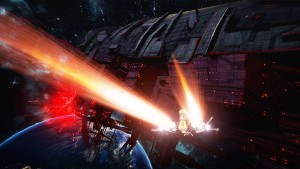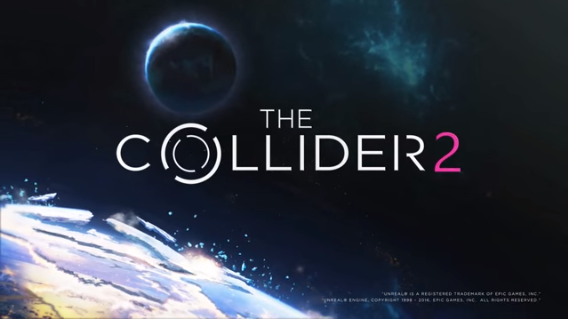In The Collider 2, ShortBreak Studios claims to have the fastest virtual reality (VR) title going. From the outside looking in that’s an appealing buzz phrase, but, to simulator sickness sufferers, this isn’t a statement you should be so eager to make. If this is indeed the Oculus Rift and HTC Vive’s quickest videogame then it surpasses Gear VR’s DRIFT, an experience that can make even the sturdiest of VR devotees dizzy. Surprisingly, though, a short time with The Collider 2 leaves the stomach in place and the brain asking for more.
Sequel to a popular sci-fi runner (not quite endless but in the same vein), The Collider 2 is a very different beast from its predecessor on a visual and control perspective, though it’s still the same linear experience at heart. Gone is the colour palette, dazzling players as they shot down obstacle-littered courses, and in their place is a decidedly more grounded art style, as you race through the innards of an enemy space ship in order to destroy it. You might well miss that distinct flair that the first videogame boasted, though this new more contemporary style does help set the more heroic tone of the David vs. Goliath battle you find yourself in.
With a head-mounted display (HMD) on, The Collider 2 is controlled through head movements, and it certainly requires an active approach. Anyone with a Gear VR is probably familiar with this genre by now and even tired of the tilt-based controls in which you keep your head on a swivel. This, however, makes use of the Oculus Rift and HTC Vive’s much more robust tracking systems. Instead of simply looking in the direction you want to send your craft, you’ll need to physically move your head over to that location. It’s very likely that this is the reason The Collider 2 remains comfortable despite its lightning speed.
There were some technical hiccups in VRFocus’ demo, namely some stiff tracking after initially working well, but when things are running as they should then VR added an engaging twist. Whether it’s intended or not, The Collider 2 feels more like objects are being thrown at you rather than you travelling towards them, making comparable to a game of dodgeball over a sprint down an obstacle course. That’s no bad thing; ducking and leaning out of the way of walls and stretching to grab coins and power ups is a great use of VR’s positional tracking. Bar the technical hitch, the controls were tight throughout.

ShortBreak Studios is also besting other VR runners with the amount of content it offers. This isn’t just an endless runner, as there’s also a six-stage mission mode that increases in difficulty as you go. Crucially, you can ease yourself in with levels in the first stage before progressing onto more challenging tasks, including boss fights that encourage you to take chances, missing attacks by the skin of your teeth as you weave around laser beams and mines. Add to that a choice of ships with varying states and there’s more than a few hours’ worth of content here.
If there’s a mystery left to The Collider 2’s VR support, then, it’s to do with balance. Without playing the non-VR version – both of which are included in the Steam purchase – it’s difficult to tell if the VR controls make the experience any easier or harder, though ShortBreak Studios itself says there isn’t a difference in it. Despite this, VRFocus suspects hardcore players will still opt for the familiarity and reliability of a control pad, but that’s not much of a problem when VR support is included as a welcome extra.
And that’s something that shouldn’t be taken lightly. With The Collider 2 you’re getting a videogame that seems to have considered development both in and out of VR. Even if you ultimately decide you’d rather play with a pad, this looks to be an addictive time waster of a sequel that won’t disappoint.















